SERP analysis is the process of analyzing websites that have made it to the top and further positions of Google search results. It makes it easy for you to check the construction of content published by your competitors and, as a result, better adjust the material on your site.
That’s it in a nutshell. The topic deserves elaboration, and we will start with the SERPs themselves. By the way, you will learn about Senuto’s new SERP analysis tool.
What is a SERP?
.
SERP is an acronym for search engine results page. It refers to a web page that shows search results when a search term is typed into a search engine. Search engines vary, and not everywhere in the world Google reigns supreme (for example, the Chinese have their Baidu), but in Poland, as in most European countries, Google has close to 100 percent of the market.
So let’s assume that when we talk about the search results page – the SERP – we’re talking about,what Google will show us when we type the search term we’re interested in into the search box and press enter (or choose a hint that pops up while we’re typing).
When we type “Senuto” into Google, it will show us something like this:
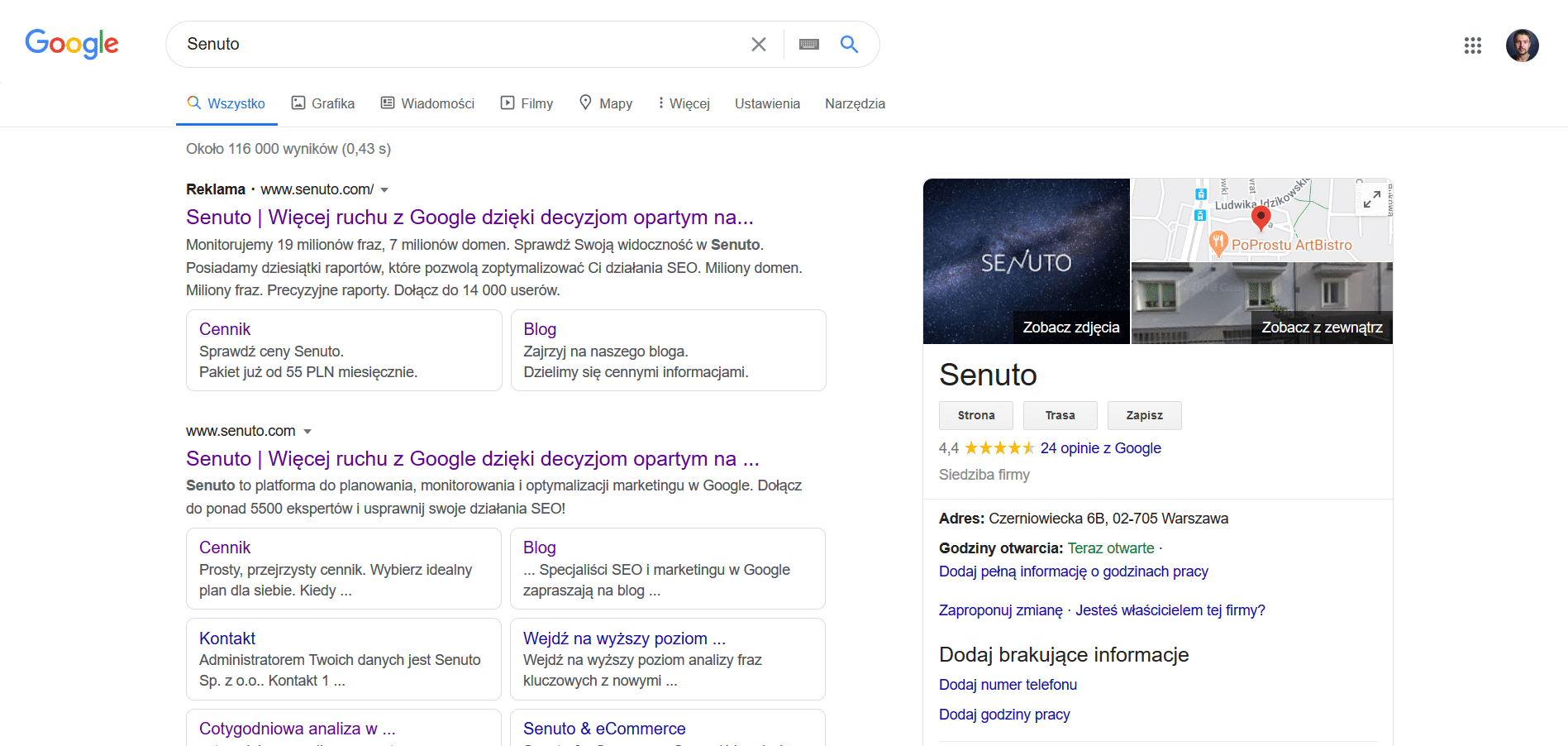
And this is the first SERP, or the first page of search results.
The SERP, of course, is not one. One page of Google is just 10 search results – and there are, after all, many more websites. So after scrolling down, if none of the first 10 results satisfy us, we can go to the second page of search results (the second SERP).
Legend has it that on the tenth SERP there are already only links to Illuminati, Reptilian and Chinese egg sellers’ sites. But this is unconfirmed information. Few people go to the second page of search results, and the 10th is a complete abstraction. I’m already explaining why I’m talking about this.
Why is the first page so important?
.
We conducted a study “What do we know about CTR from SEO?“, which clearly showed the impact of Google ranking position on website traffic. CTR stands for click-through rate, orclick-through rate. We divide the number of people who saw the link by the number of people who clicked on it, and this is how we get the CTR. If 20 out of 100 people clicked, the CTR is 20%. Easy.
As you can see in the chart below, the CTR for the first result on the first SERP is 21.5%.
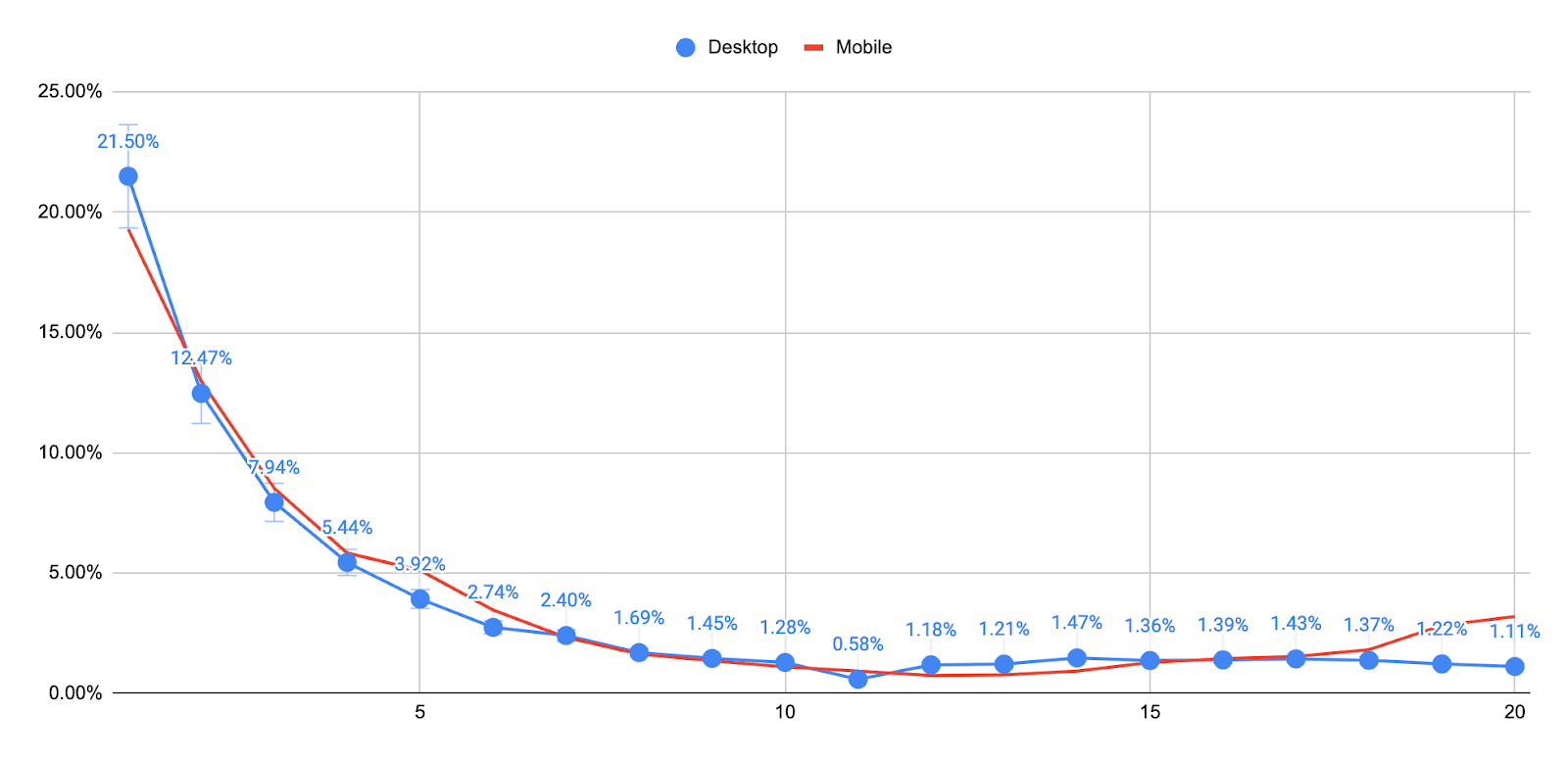
The fifth position, on the other hand, is only 3.92% (and that’s still the first page!), while the bottom positions of the first page and the results found on the second page have a CTR of around 1%. This means that even if someone already goes to that second page of search results, the clickability of the links to the pages there is completely marginal.
The conclusion here is that if you care about increasing organic traffic (coming from Google) to your website, then in practice, only the first page of search results matters. That’s where you need to target with keyword phrases for which your site should be visible in the search engine. Someone whose site has no phrases in the TOP 10 will not record organic traffic from Google or will record trace amounts of it.
Sign up for Senuto’s newsletter! Fresh content from the blog straight to your inbox.
Naturally, the question arises,how to get into the top search results for my chosen key phrases. The answer would be quite long and complicated.
Therefore, let’s look at it from a different angle, ask a different question.
How did others do it to get in the TOP 10?
.
Search engine optimization (SEO) is a process that has many components. And one of the most important iscontent optimization. Content writer has written an article for the company’s blog – how is it that it is precisely this article that displays, for example, in the first or third place in search results, on the first SERP? How is it that another article with similar information ranked much lower?
Leaving aside other factors, such as page loading speed (technical aspect) or the number and quality of backlinks (links leading to the article), the way the content was constructed certainly played a big role.
The information in the two articles may be similar – but for Google’s algorithms, the form of the information also matters. There are certain rules by which the search engine operates. All copywriters, people creating content marketing or even online journalists must take these rules into account if they care about better rankings.
What, then, is important in terms of article construction? Among others:
- Keywords – in what form and how many times a keyword appears in the content.
- Title – whether it contains the keyword phrase.
- Headers – whether and how many H1, H2, and H3 headers, i.e., lower- and higher-order ones, are used.
.
With this information, you gain valuable insight into how your direct competition is performing – that is, companies whose sites are showing up for the keyword phrases you are interested in in the top search results.
This is the information provided by SERP Analysis, a new module available within the Senuto platform. The way the thing works is that you enter the keyword you’re interested in, for example, “birthday cake” – a strong business phrase if you run a cake shop – and you get a report that includes the TOP 10 search results on Google.
SERP analysis is a kind ofanatomy of content created by entities with which you compete for high positions in Google search results. Perhaps you run a large e-commerce store, own a candy store or are a budding blogger trying to find your niche. In any case, SERP analysis will tell you a lot about who you need to “pore over” a bit in Google to achieve your goals.
We type in the phrase “birthday cake” and going from the top, the report looks like this:
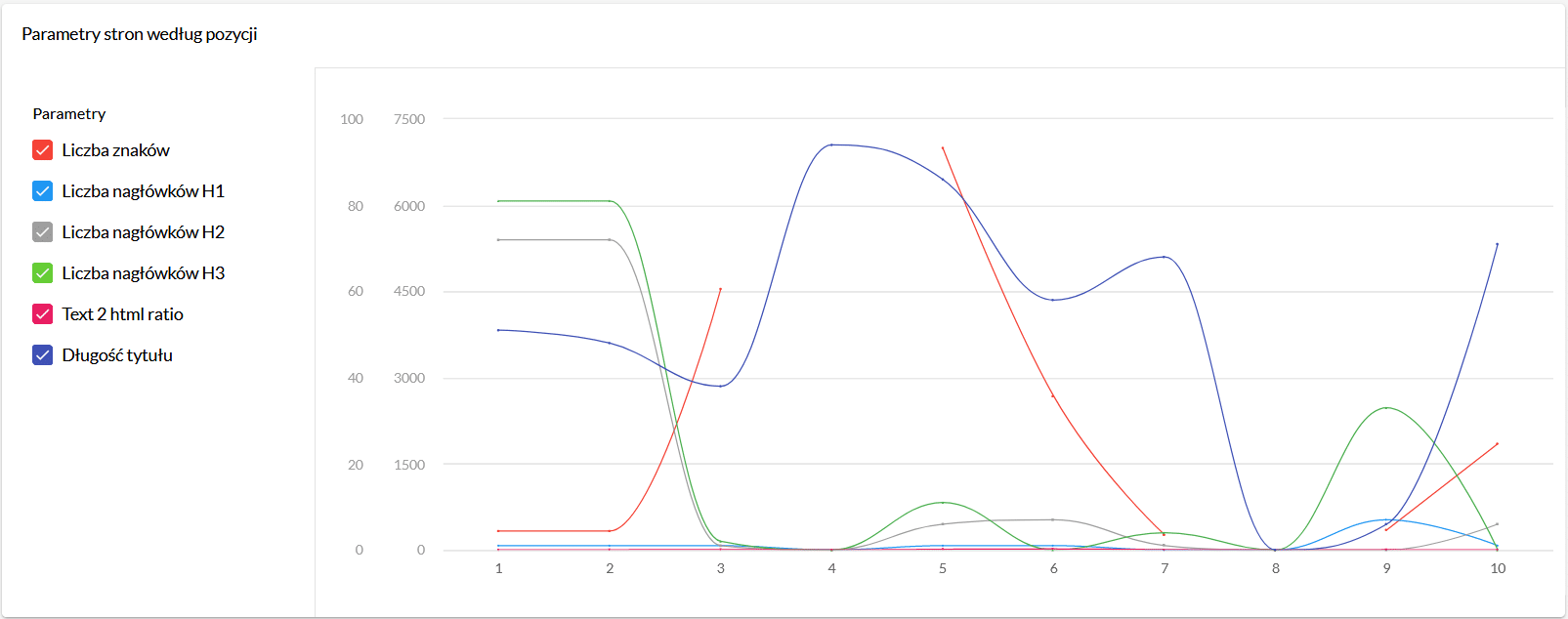 .
.
As I mentioned above, from the point of view of SEO – optimizing content for search engines – titles and headings are very important; the Senuto report further provides information about the ratio of text to html code, as well as the length of content and title.
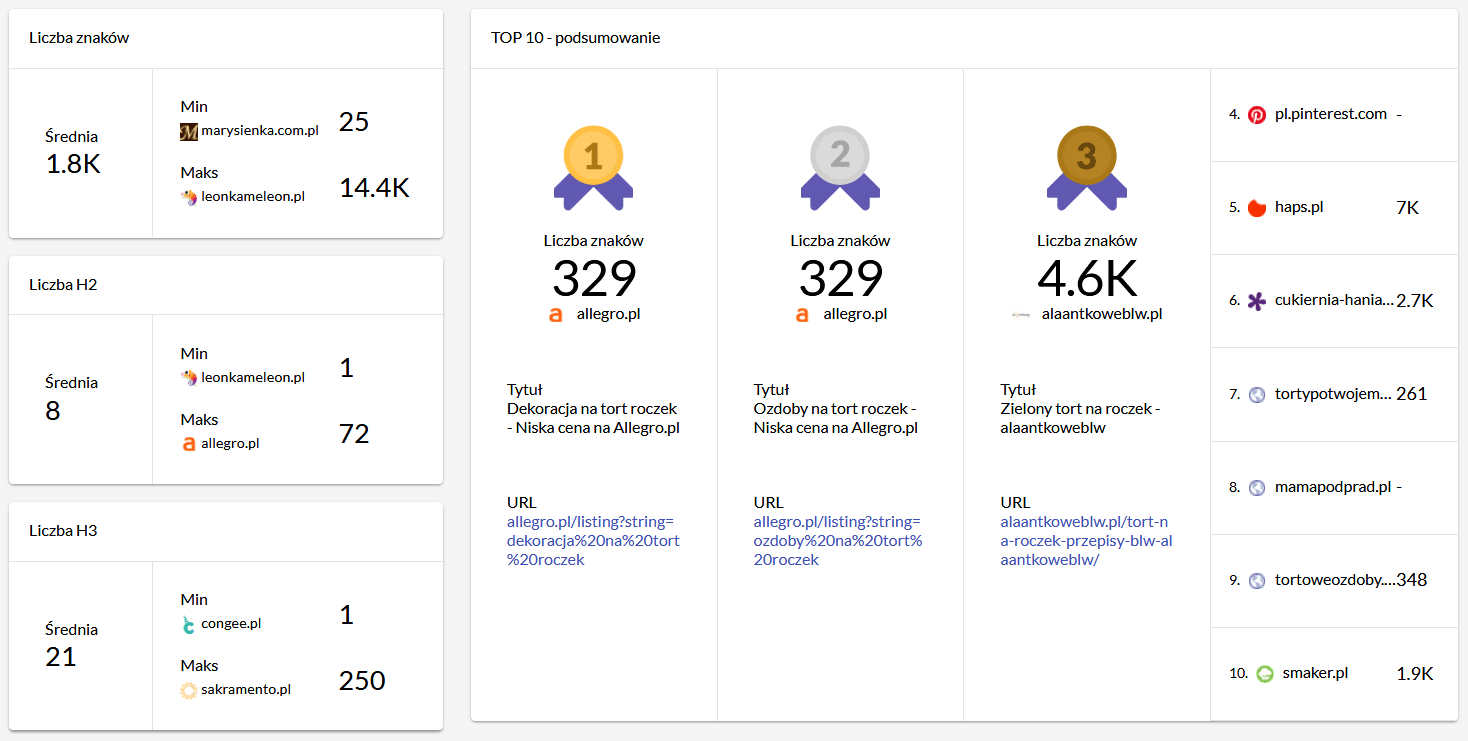
And here’s,how the top ranked search results for the phrase “cake for a birthday party” – and what the averages look like in terms of text length, number of headlines, etc.
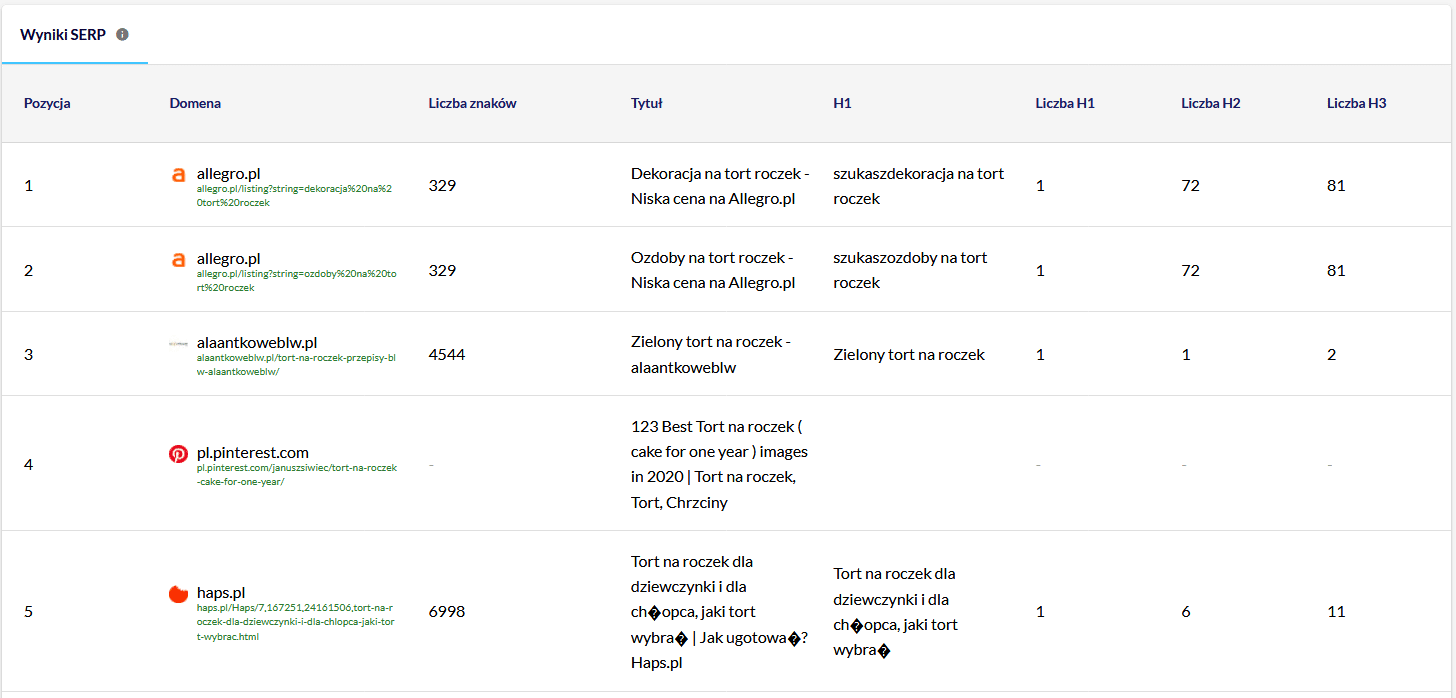
Below the “medalists” we see a detailed ranking. In the screenshot above, only the first five positions are visible, but SERP analysis takes into account a total of the first 10 results (for now, there will be more!). You can view them all for yourself and analyze them for statistics. It’s also worth checking what title tag and H1 header your competitors have used.
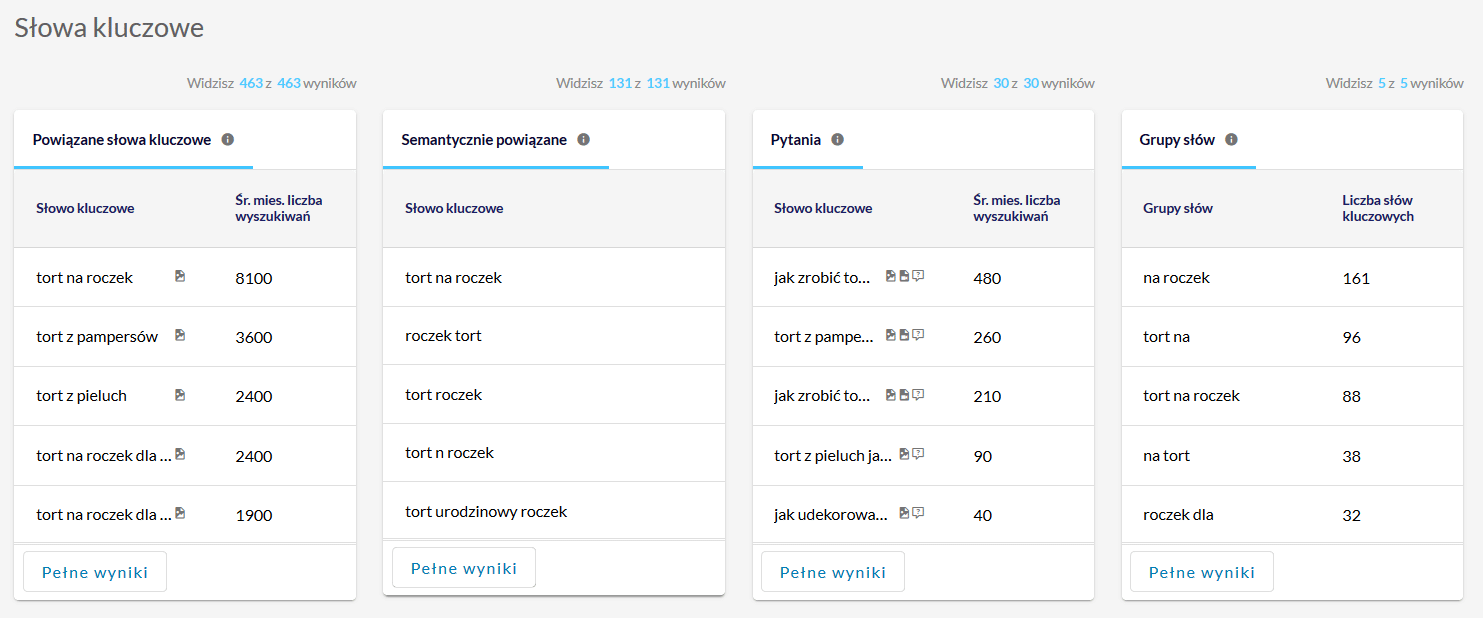
At the very end of the report, in the Keywords section, there is a list:
- related keywords,
- semantic links,
- questions that people type into Google,
- groups of words,
.
.
.
.
When you combine this with the rest of the statistics,you get a convenient and very practical insight into a range of relevant information that you can use to optimize your texts for the search engine.
If the articles in the TOP 10 each have an average of 4 headers of H2, you too should aim for 4 headers. If the top ranking article on Google is 1,200 words, and you came out with an 800-word text, consider making it longer. If you notice a certain pattern when it comes to building titles of texts that rank high, try to fit into it. In other words: model yourself after those who have succeeded.
Add to this your knowledge of keywords, and you will understand how much you can gain from analyzing SERP results from this angle.
What is SERP Analysis for – summary
.
So, if you are a copywriter or content marketer and writing according to SEO requirements is an important part of your work, SERP analysis can make your life much easier. Thanks to it:
- Easily check the content and design of your competitors’ articles to understand what influenced their search engine success,
- You will discover correlations between page positions in the SERPs and such factors as number of headings, text length, text-to-code ratio of pages, content of titles and metatitles,
- And finally: you’ll be able to apply all this information to develop the article design yourself and better tailor it for SEO.
.
.
.
At the end of the day, it’s all aboutwriting texts in such a way as to maximize the likelihood of being ranked high in Google. As I mentioned before, getting into the top search results depends on many factors. But if you’re thinking about this game seriously, let SERP analysis be another building block to improve your overall SEO efforts.
You can find a full description of the SERP Analysis module in our Knowledge Base.
And below is a short video about the module’s capabilities:
 Wojciech Maroszek
Wojciech Maroszek